Thursday, June 25, 2009
Wednesday, June 24, 2009
Rockin' Russians
 Mother Russia, home of the great constructivist graphic designers like El Lissitsky, Vladimir Majakovsky and Alexander Rodchenko. Home also, to the anonymous artists behind this collection of brilliant, amusing and downright frightening collection of Russian album covers.
Mother Russia, home of the great constructivist graphic designers like El Lissitsky, Vladimir Majakovsky and Alexander Rodchenko. Home also, to the anonymous artists behind this collection of brilliant, amusing and downright frightening collection of Russian album covers.
Monday, June 22, 2009
The Last Night Of The Fair
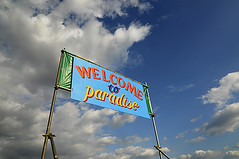
Yesterday, we visited Carters Steam Fair at Victoria Park in 'ackney. The Olympic construction has closed all the short cuts to the lungs of the East End, which is a bind if you don't want to travel by car, scooter or - God help us - bus. Until 2012, getting there means cycling along the Eastway, a scratty stretch of rampant Buddleija davidii, ejected coke cans and car batteries. It's the very definition of one of Iain Sinclair's Edgelands.
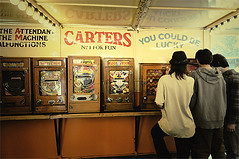
'Vicky' park (as it's always know to Hackneyites like Mrs TIW) is the perfect setting for John Carter's Famous Royal Berkshire Steam Fair, an utterly glorious collection of original fairground rides and sideshows that's been touring the southeast for 30-odd years. There's waltzers, dodgems, swingboats, chair-o-planes, cork-firing rifles and hook-a-duck. There are those things where you hit a button with a huge mallet in a vain attempt to ring a bell. There's a penny arcade overseen by a superannuated rocker with a quiff and a comb in his back pocket. The deliciously bling Gallopers ride has been used every season since 1895, still powered by a steam engine that also runs a tootling 'calliope' organ. All the rides are tugged about the country by vintage trucks, and the staff live in original showmens' caravans, all in immaculate condition. It's magical, especially at night - i've never seen so many smiling Londoners.
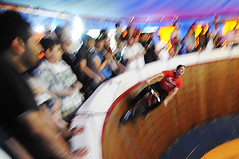
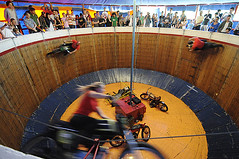
Along with the fair was Ken Fox's Wall Of Death, one of only - it is thought - two left in the country. Compared to Carter's venerable attractions, this wall is practically new - it was built in 1995 at a Liverpool shipyard. In a Britain slowly suffocating with 'elf 'n' safety legislation, to be able to watch 3 riders on 1920s Indian bikes racing each other round the inside of a huge, creaking wooden barrel is something else. No helmets, natch, and often no hands as they roared around only 8 or so inches from the lip of the wall. At the end of the show an obvious question was answered without being asked - no insurance company will touch them, so the riders depend on donations from their audience, who shower the daredevils with pound coins and the odd fluttering tenner. Money very well spent.
Thursday, June 18, 2009
Swingin' Safari

Sacha Baron-Cohen's latest flick Brüno is out today, which is as good a reason as any to mention his family's shop. Baron Of Piccadilly have been punting togs to discerning gents for decades at 210 Piccadilly. Seemingly aloof of all that fashion nonsense, it's probably the last place in Britain where a chap can still get a safari suit.
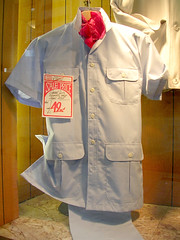
Monday, June 15, 2009
Swarmy Weather
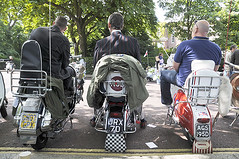
I think this is the ninth time I've been on the Great London Rideout. Ten if you count the time I turned up on a bicycle to watch - a brief and unpleasant encounter with a Camden bus the week before had rendered me temporarily scootless (1967 Sprint V 'Sophia', RIP).
Numbers seemed to be slightly down on previous years, perhaps the credit crunch making its presence felt in a desire for a family holiday rather than essential repairs to clutch or exhaust. Still, there must have been 400 or so scooters in Regents Park, buzzing like a swarm of angry bees (or more properly, wasps) farting two-stroke when the organiser blew his horn half an hour late. A PHd could be earned working out how all theses scooters somehow all avoid each other in the initial melée - it's like a two-wheeled ballet.

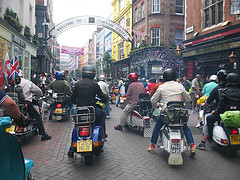
These things are always badly organised, scootering being an essentially amateur pastime, but that's half the fun. As usual, nobody knew where we were going, just that Southend was the ultimate destination. On Regent Street - to the delight of dozens of goggling tourists - half the péloton took a left on to Carnaby Street and immediatly parked up, while some of us did a U-turn and joined the rest of the pack through Piccadilly, Trafalgar Square and along the Embankment, Upper and Lower Thames street, Tower Hill and the Mile End road. We eventually lost the biggest group somewhere near the Bow flyover, though their huge cloud of blue smoke could clearly be seen in the distance, like a b-movie monster on its way to devour Southend.
Friday, June 12, 2009
Rocking Roll
It has been speculated that one reason the Americans suffered so heavily on D-Day was their reluctance to adopt the 'funnies' - experimental kit developed by the British for theirs and the Canadian beaches. Gold, Sword and Juno were no picnic on D-Day, but this revolutionary equipment undoubtedly saved lives.
Tests of the Panjandrum were carried out in full view of crowds of holidaymakers, and it's this lack of secrecy that has lead some historians to believe that the whole thing was some sort of elaborate double bluff, to keep attention away from the real 'funnies', tested more covertly in Suffolk.
A couple of weeks ago, as part of the Appledore Book festival a replica was launched on the same stretch of Westward Ho beach - and thanks to 'elf 'n' safety restrictions it was much less hair-raising, but still spectacular.
Some of this new gear was hugely succesful, like the mine-clearing 'flail' tank or the AVRE, based on the Churchill tank that came in umpteen variants, including anti-bunker, ditch filling and bridging roles. However, many of the 'funnies' barely made it past the planning stages. One such project was the ten-foot rocket propelled wheel known as the Great Panjandrum. The idea was that this would roll up the invasion beach, crushing all obstacles in its path before exploding at a pre-determined target. However, tests of a prototype round the coast from Braunton at Westward Ho proved to be as dangerous to the launchers as the enemy, as witnessed by BBC correspondent Brian Johnson:
"At first all went well. Panjandrum rolled into the sea and began to head for the shore, the Brass Hats watching through binoculars from the top of a pebble ridge. Then a clamp gave: first one, then two more rockets broke free: Panjandrum began to lurch ominously. It hit a line of small craters in the sand and began to turn to starboard careering towards (recording cameraman) Klemantaski, who, viewing events through a telescopic lens, misjudged the distance and continued filming. Hearing the approaching roar he looked up from his viewfinder to see Panjandrum, shedding live rockets in all directions, heading straight for him. As he ran for his life, he glimpsed the assembled admirals and generals diving for cover behind the pebble ridge into barbed-wire entanglements. Panjandrum was now heading back to the sea but crashed on to the sand where it disintegrated in violent explosions, rockets tearing across the beach at great speed."
Tests of the Panjandrum were carried out in full view of crowds of holidaymakers, and it's this lack of secrecy that has lead some historians to believe that the whole thing was some sort of elaborate double bluff, to keep attention away from the real 'funnies', tested more covertly in Suffolk.
A couple of weeks ago, as part of the Appledore Book festival a replica was launched on the same stretch of Westward Ho beach - and thanks to 'elf 'n' safety restrictions it was much less hair-raising, but still spectacular.
Tuesday, June 9, 2009
The Crow Road
 Near Barnstaple in North Devon are the Braunton Burrows, the largest sand dune system in the British Isles, and a UNESCO biosphere reserve. It's a huge, wind-washed tract of marram grass, dandelions and purple thyme where it's easy to get lost among the sandy hills and gorse and swooping, trilling skylarks. In 1943 this area was selected by Lieutenant Colonel Paul Thompson of the US Army as a training area for the planned allied assault on Normandy. What became know as the US Assault Training Centre was temporary home to thousands of young Americans, living under canvas, in Nissen huts and billeted in nearby villages. The bumpy track from the Burrows car park is still known locally as the American Road and leads to an open area of grass and dunes where this dummy landing craft still stands. There are four or five others - some with wartime graffiti - which are slowly being reclaimed by nature. These concrete replicas of 'Higgins Boats' were used by troops to rehearse what they'd be doing in deadly, bloody earnest on Omaha and Utah beaches 65 years ago, almost to the day.
Near Barnstaple in North Devon are the Braunton Burrows, the largest sand dune system in the British Isles, and a UNESCO biosphere reserve. It's a huge, wind-washed tract of marram grass, dandelions and purple thyme where it's easy to get lost among the sandy hills and gorse and swooping, trilling skylarks. In 1943 this area was selected by Lieutenant Colonel Paul Thompson of the US Army as a training area for the planned allied assault on Normandy. What became know as the US Assault Training Centre was temporary home to thousands of young Americans, living under canvas, in Nissen huts and billeted in nearby villages. The bumpy track from the Burrows car park is still known locally as the American Road and leads to an open area of grass and dunes where this dummy landing craft still stands. There are four or five others - some with wartime graffiti - which are slowly being reclaimed by nature. These concrete replicas of 'Higgins Boats' were used by troops to rehearse what they'd be doing in deadly, bloody earnest on Omaha and Utah beaches 65 years ago, almost to the day.

Thursday, June 4, 2009
Metalheads
 I started college just when the Apple Macintosh was coming in as a viable tool for the print industry. A typical day's study would have us getting familiar with the astonishing Mac II in the morning, and then handsetting metal type or gloriously tactile woodface in the afternoon. I've spent the last 20 years using Macs, but In a post-computer wasteland I could still set a galley and lock it into a Heidelberg 'windmill' platen, should the need arise.
I started college just when the Apple Macintosh was coming in as a viable tool for the print industry. A typical day's study would have us getting familiar with the astonishing Mac II in the morning, and then handsetting metal type or gloriously tactile woodface in the afternoon. I've spent the last 20 years using Macs, but In a post-computer wasteland I could still set a galley and lock it into a Heidelberg 'windmill' platen, should the need arise.Other than craft printers like the almighty Alan Kitching, it's rare to see any sort of new analogue printing. Two of the last places to use woodface and moveable metal type were circus posters and, somewhat bizarrely, the signs for polling stations put up at election time. Recent sightings confirm that both of these have now entered the digital age.
Supping a pint of Cousin Jack on my last visit to Appledore's Coach And Horses, my eye was drawn to Bideford rugby club's fixture poster. To my delight I noticed that it was all set in metal - and at the top there in red - a woodface.
 The advert up the side for Apex brought back memories of my first proper job. As a stopgap between further and higher education I worked as a 'finished artist' at a family owned printers in Bradford. Because I could draw, I often had to knock up just this type of illustration. My artwork would be made into letterpress plates and printed on Victorian machines in the basement. It was a dismal place to work. I stuck it out for 18 months before I announced that I was off back to college. The boss sacked me on the spot and he could have justifiably booted me out of the door, but he wished me well and gave me the equivalent of a week's wages from his own pocket.
The advert up the side for Apex brought back memories of my first proper job. As a stopgap between further and higher education I worked as a 'finished artist' at a family owned printers in Bradford. Because I could draw, I often had to knock up just this type of illustration. My artwork would be made into letterpress plates and printed on Victorian machines in the basement. It was a dismal place to work. I stuck it out for 18 months before I announced that I was off back to college. The boss sacked me on the spot and he could have justifiably booted me out of the door, but he wished me well and gave me the equivalent of a week's wages from his own pocket. It's still the worst job I've ever had. The reasons are very many, but one is the time the boss's son came in and told us we couldn't have an expected (and much needed) pay rise because he'd bought himself, his wife and his daughters new cars instead. Sorry, lads.
Wednesday, June 3, 2009
Anchorage
My good pal Stu had his stag do on saturday. The original plan was to start the day with a few jars somewhere, and then shoot some clay pigeons. Someone who'd been to university rather than art college then pointed out that firearms+booze=widows, so we kicked off the day at All Star Lanes in Shoreditch instead. This was my first visit to this convincing replica of 50s Americana, and I fully expected the bar to serve the bland megabooze so often associated with this sort of place. Yes, there was a tap of Coors Light - but next to it was Anchor Steam from San Francisco, and in front of a veritable Manhattan skyline of cocktail mixers was a bottle of Taylor's Landlord - the first time I've ever seen a bottle behind a London bar.
I've had bottled Anchor Steam, but it didn't make much of an impression on me. This draught stuff was glorious - a deep copper colour and a perfect balance of hops and malts with light, buttery notes. Just a superb beer for a hot day, and I found myself wishing it was easier to find. When I'm out on the pop in summer, I don't always want a cellar-temperature ale and most chilled alternatives in an average british boozer aren't even worth considering. Strongbow? Stella? Meh.
It was such a refreshing change to visit somewhere with a bit of imagination. Typically, a trip to the bar of any leisure venue from bingo to cinema confronts you with the choice of Fosters, Guinness or - God help us - John Smith Smooth.

(I didn't have my camera with me - so here's a picture of the Anchor on Appledore Quay, Devon)
I've had bottled Anchor Steam, but it didn't make much of an impression on me. This draught stuff was glorious - a deep copper colour and a perfect balance of hops and malts with light, buttery notes. Just a superb beer for a hot day, and I found myself wishing it was easier to find. When I'm out on the pop in summer, I don't always want a cellar-temperature ale and most chilled alternatives in an average british boozer aren't even worth considering. Strongbow? Stella? Meh.
It was such a refreshing change to visit somewhere with a bit of imagination. Typically, a trip to the bar of any leisure venue from bingo to cinema confronts you with the choice of Fosters, Guinness or - God help us - John Smith Smooth.

(I didn't have my camera with me - so here's a picture of the Anchor on Appledore Quay, Devon)
Subscribe to:
Posts (Atom)
